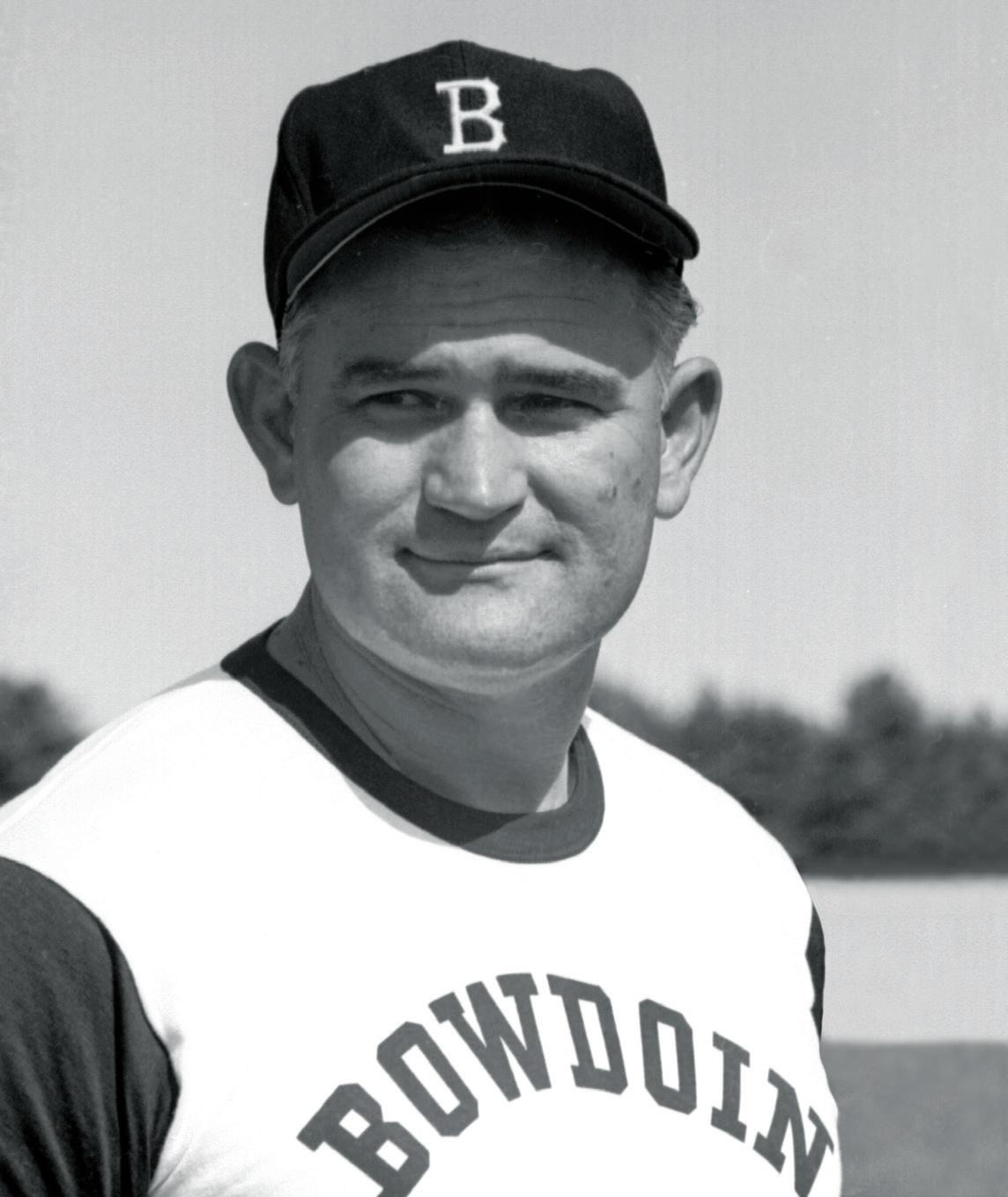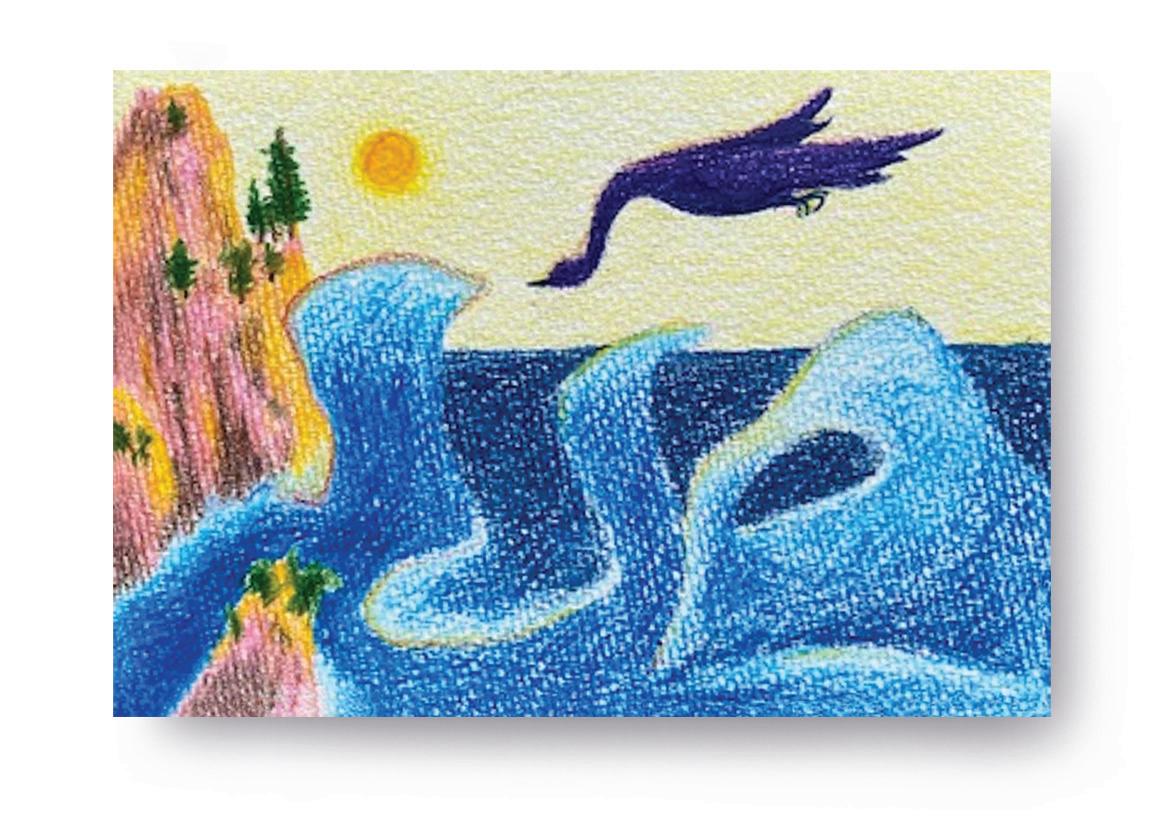
9 minute read
UV Light: Professor Dale Syphers and Joyce Bor ’22 fi ght viruses with physics.
Katelyn Cox ’21 cheers on Maddie Rouhana ’21, who slid safely into home on a sacrifice fly by Ruby Siltanen ’21 in the second inning of a high-scoring, 15-10 victory over Colby on April 18 at Pickard Field. Academics
UV Light
WHEN THE PANDEMIC HIT in March 2020, Professor of Physics Dale Syphers was in the middle of his sabbatical, researching forensic physics. He “turned on a dime” and threw himself into the study of how ultraviolet (UV) light can be deployed in the fight against COVID-19 and other viruses. Exposing personal protective equipment, like N-95 respirators, to shortwave ultraviolet light clears them of active viruses, allowing health care workers to safely reuse the gear. But over time, repeated exposure to UV light can degrade the mask materials, making them ineffective.
With research assistant Joyce Bor ’22, Syphers has been investigating the shortest amount of time respirators need to be exposed to UV light, and at what level, to render viral loads inactive. While 99 percent of the viral load on a mask is killed within the first few seconds of UV exposure, the remaining 1 percent takes twenty times longer to become deactivated. As UV beams penetrate a mask, photons bounce off the fibers of the filter layers. Some of the UV light bounces backward before doubling back and piercing the mask, slowing the deactivation process. In collaboration with a virologist at the University of New England, Bor and Syphers conduct their UV exposure experiments in a box constructed specifically to deactivate viruses on N-95 masks. The intention is to send these boxes, with assistance from international relief agencies, to clinics around the world.
“In the long run, we believe the UV box under development could be especially useful in areas of the world with limited means, allowing N-95 respirators to be reused safely up to twenty-five times, and probably useful here in the US for everything from EMTs to doctors’ offices and hospitals,” Syphers said.
Additionally, the findings Syphers and Bor have made into how UV light bounces off mask fibers could lead to better-designed masks that can be reused even more often—perhaps hundreds of times.
Forward
Alumni Life
Celebrating Our Community
Even in the face of a virtual-only format, Reunion 2021 did not disappoint. Classes that were slated to celebrate a reunion in 2021 and 2020 were offered a wide array of online programming opportunities—a mix of nearly twenty all-inclusive and classspecific events, both live and prerecorded, that was available starting in April. Live events ranged from discussions with medical and life sciences experts on the impacts of COVID-19 to a conversation with artist Shaun Leonardo ’01, a talk about the Bowdoin endowment, and a presentation on how to make the perfect lobster roll. Many of the offerings were open to all alumni, including the Convocation celebration of alumni award winners and a prerecorded conversation between President Clayton Rose and Bowdoin trustee and editor-in-chief of Yahoo! Finance Andy Serwer ’81, P’16, P’20. Both of these events, and a good selection of nearly all of the programming—including a variety of campus tours—can still be accessed at bowdoin.edu/reunion.
Archives
BOWDOIN STORIES
Last spring, when campus life shifted in response to the pandemic, the George J. Mitchell Department of Special Collections & Archives invited the community to participate in Bowdoin Stories, a program first launched in 2015 that encouraged students to engage in short interviews and become part of the College’s history while they were still on campus. The new version of the initiative welcomes students, faculty, staff, and alumni to contribute accounts of their experiences with COVID-19 in the interest of fostering connections and preserving a record for posterity. Submissions may be made on paper or digitally, and can take the form of prose, poetry, art, or anything that helps reflect current lived experiences. To contribute, or to read what has been collected so far, go to bowdo.in/covid-stories.
Sustainability

Green Tea
Originally brewed as a WBOR radio program, Green Tea became a popular podcast steeped in sustainability and the environment.
WITH TWENTY-SEVEN EPISODES now available on Soundcloud and iTunes, the recent fourth season of the Green Tea podcast was hosted by Holden Turner ’21 and Juliette Min ’22, and “explored new angles of sustainability,” covering topics from plant medicine and ecological anthropology to coral ecology and eco-feminism. The latter two subjects were addressed together, by Visiting Assistant Professor of Biology Justin Baumann, who was a guest on the show.
Diego Velasquez ’20 and Marie Caspard ’20 launched Green Tea in fall 2019, first as a radio show on WBOR. They expanded it to a podcast as a way to explore sustainability through personal stories, and arranged interviews with students, faculty, staff, and community members. Velasquez and Caspard also wanted to convey hope about a subject that is often grim, and provide information and inspiration to compel action. “Positive inspiration is one of our goals,” Velasquez said.
Turner joined Caspard last fall and took over with Min this spring. They’ll continue as cohosts through next autumn. “The show is a great excuse to speak with people I’d never meet otherwise,” Turner said. “Especially now, you can’t have casual meet-ups where you simply hear stories from students and professors around campus. Green Tea fills that gap a little.”
Athletics
LINKING UP WITH LINK
He may have retired nearly thirty years ago, but Mike Linkovich—known by generations as “Link”—still looms large on campus. The former athletic trainer, who came to Bowdoin in 1954, is someone whose dedication, sense of humor, and charisma have made him part of the fabric of the Bowdoin community, says Assistant Athletic Director Kevin Loney. Pre-pandemic, Link could be seen socializing at football games, in regular lunches at Thorne, and working out in the fitness center. Decades of Bowdoin athletes have a Link anecdote up their sleeve.
With Link incapacitated after losing a toe in a 2019 car accident and unable to receive many visitors, his extensive network of friends found a way to stay in touch. For several months now, Loney has organized regular Zoom chats, enabling Link, now ninety-nine, to catch up with alumni from around the country, most of them athletes from the 1960s through the 1980s. “Link loves these weekly conversations,” Loney said. Every week, a handful of alumni reminisce with Link, comparing war stories and injuries. “Link remembers everything—his mind is still sharp as a tack. They don’t make them like him anymore.”
Former athletic trainer Mike “Link” Linkovich is a timeless Bowdoin personality. On the Shelf

Breaking the Social Media Prism: How to Make Our Platforms Less Polarizing
CHRIS BAIL ’02 (Princeton University Press, 2021)
In this data-driven explanation of how social media platforms polarize us and how individual users can make changes that will make the platforms more tolerable, Chris Bail—professor of sociology and public policy at Duke University—argues the problems that plague social media today have a deeper cause, and he lays out new ideas and technologies to make changes.
The Future History of Contemporary Chinese Art PEGGY WANG, associate professor of art history (University of Minnesota Press, 2020)
Drugs and Thugs: The History and Future of America’s War on Drugs
RUSSELL CRANDALL ’94 (Yale University Press, 2020) I, Grape; or The Case for Fiction: Essays
BROCK CLARKE, A. LeRoy Greason Professor of English (Acre Books, 2021)
Sovereign Attachments: Masculinity, Muslimness, and Affective Politics in Pakistan
SHENILA KHOJA-MOOLJI, assistant professor of gender, sexuality, and women’s studies (University of California Press, 2021)
Forward
Student Life
Stamped with a Smile

The Mail Art Collective encourages students to reach out to members of the community by mailing hand-painted postcards.
“I FIRST TRIED THE IDEA in my Painting I class last fall to build a sense of community beyond our Zoom meetings,” writes Mary Hart, a visiting assistant professor of art. “At fi rst, I had the students send the cards to each other. The idea grew, and now we have a partnership with Mid Coast Senior Care Center so students can connect with residents there. I like the idea that art is something everyone can do, and it’s free!”
Launched by two of Hart’s students, Elena Sparrow ’22 and Dalia Tabachnik ’21, the initiative now involves around sixty students. “With so many people being isolated both geographically and in their day-to-day lives due to the pandemic,” says Sparrow, “we hoped that creating this community and mode of communication would be helpful to keep people connected and supported.” “There are so many ways to fi ll a blank postcard as far as how you decorate it, but also as far as what you communicate with it,” writes Tabachnik. “With these postcards I feel like we each give a stranger on the other end a piece of ourselves, which sparks joy in both parties and brightens someone’s day when it arrives in their mailbox.”
Above: Elena Sparrow ’22 and Dalia Tabachnik ’21 collaborated on this postcard for the Mail Art Collective’s theme “happy accidents.” Sound Bite
—NASA ASTRONAUT JESSICA MEIR H’21 IN HER MAY 26 “FIRESIDE CHAT” WITH THE BOWDOIN COMMUNITY, DESCRIBING THE PERSPECTIVE OF LOOKING AT THE EARTH FROM SPACE
Campaign
Access and Affordability
The support and generosity of alumni, families, and friends, in combination with the performance of Bowdoin’s endowment, enabled the College to make two signifi cant changes recently to its fi nancial aid policies. First, the summer earnings contribution requirement—which had typically been $2,300—has been eliminated for students whose family income is less than $75,000. Second, the College has adjusted its fi nancial aid calculation methodology in ways that increase support for both low- and middle-income families.
These moves will increase Bowdoin’s fi nancial aid budget by roughly $3.5 million annually. “This increase to the aid budget refl ects Bowdoin’s steadfast commitment to need-based aid and to equitably addressing affordability and the needs of our families,” says Whitney Soule, Bowdoin’s senior vice president and dean of admissions and student aid.
Bowdoin is need-blind—that is, a family’s ability to pay is not a factor in admission—and the College meets the full determined fi nancial need with aid packages that include grants, not loans. Bowdoin is one of only nineteen colleges in the country that are able to offer this need-blind, meet-full-need, no-loan approach. The From Here campaign aims to provide $200 million in new endowment for fi nancial aid and, as of May, is about 60 percent of the way toward reaching that goal.
In Season
TAKING THE PLUNGE
Reading period began with a splash on May 19 as students took the opportunity to get outside in the warm spring sun for some carnival-like fun before diving into finals. It may have been nearly 80 degrees on the Quad, but as President Clayton Rose can attest, the water in the dunk tank was still chilly!







